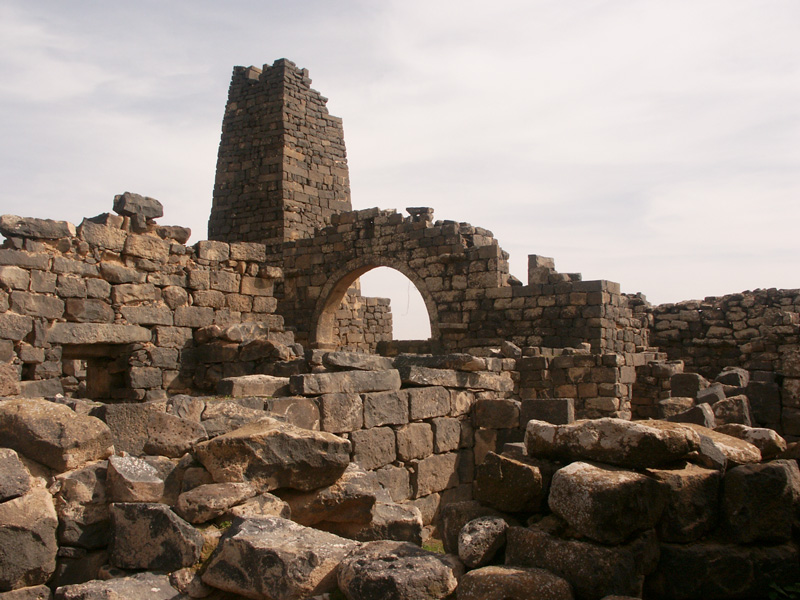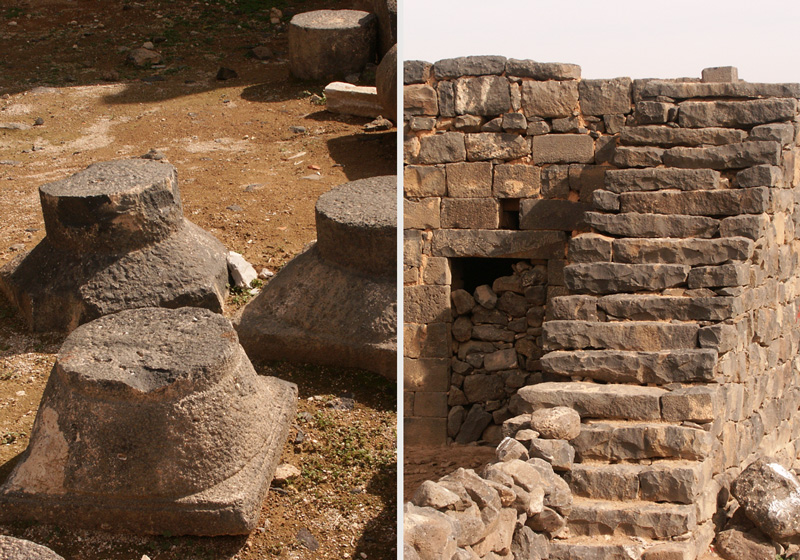Um-Masrab
Along all the borders between Jordan and its neighboring countries, nowhere do you find villages on both sides that are more in amazing proximity than the area of northern Jordan and the Syrian Houran. While the Yarmouk gorge separates Jordan from Syria towards the west, the landscape becomes continuous in the east and in the region north of Um el Jimal –villages, few kilometers apart, continue on both sides of the borders without any natural boundary and seemingly ignoring the political one.
The group of the Jordanian villages between the crossing point of Jaber and all the way east to Dair al Kahf, along Jordan’s northern borderline, are all built of black basalt. They all have centers with archeological remains, and feel like an extension of Jabal al Arab (also called Jabal al Drouz) visible across the borders to the north.
Maghayer Al Sarhan, Um Masrab, Baa’ij, Sabha, Um Al Quttain, Dair Al Qin, Dair Al Kahf and others are situated as a line on the southern foot of Jabal Al Arab. Each one of these villages has a special attraction, an archeological monument or a traditional historical core. Among them, Um Masrab has the most impressive site. The archeology of this small village might well be the second largest site after Um el Jimal and being beautifully conserved it is somewhat more pleasant as it forms the heart of the modern village.
Archeological references mention the name of this village as “Um el Surab”, “Um es-Sirb” or "Um Al Sarab", while the locals pronounces it “Um-Masrab”. Regardless of the different pronunciations of the name, and thus the different possible meanings, Um-Masrab has an impressive history.

From general archaeological surveys, the site could be dated to at least the Nabataean and Roman times. In this context one should note that only about 20 km to the northeast of this village, across the borders in Syria, was Bosra, the important Late Nabataean city and the capital of the Roman province of Arabia. The golden age of Um-Masrab was during the Byzantine period with the construction of three churches –known to date. Of these which St. Sergius and Bacchus (dated AD 489) was the largest and functioned as the center of a monastery complex. So prosperous was this site that, during the Byzantine period, the church was decorated with glass mosaics to furnish the floors and possibly some of the walls.
The tower of this church, which stands today as an impressive landmark giving the skyline of the village its distinctive character, was added after the coming of Islam. Later on, the apse of the church was closed and other alterations took place to convert it into mosque.
From the Umayyad period to the Mamluk period, settlement on this site seems to have declined, or even ceased, as archeologists suggest based on pottery fragments. This decline represents a typical regional trend that took place in all of the settlements of Houran in Jordan and southern Syria.
The archaeology of Um-Masrab and the many other villages to the east should be seen within the larger geographic and geological context. Behind every archeological site is a geological story, and the story of this region of Jordan with its unique monuments, is centered on the volcanic activities that shaped this landscape.
The basalt, as a building material, is basically the igneous rock of the volcanic geological formation that is collectively called Harret Al Sham. Some of the older basalt of the eastern parts of this landscape can date to 13.7 million years. Volcanic activities continued since that date, and some of the youngest eruptions occurred as recently as half a million years ago or even later. In parts of Houran, in Syria, eruptions as recent as 2000 years ago were reported by volcanologists. The basalt of Um-Masrab is of the younger volcanoes, dating to the Pliocene- Holocene epoch, during which eruptions dating to 1.4, 0.48, and 0.1 million years took place.

The villages of this basalt highland and their inseparable natural and cultural heritage represent a little-known corner of Jordan, a destination that remains hidden away –keeping a pleasant surprise in store for us.
These villages of basalt archeological remains are nearer to Amman than we think; in fact the village of Um-Masrab is only about 50 km away from here. This destination can be visited easily in one or even half a day. You can combine many of these villages with other near by and more famous sites such as Um- el Jimal or Azraq. From Amman, drive on the Damascus highway - at Mafraq, exit heading northeast on smaller village roads, ask for directions to Um-Masrab. From there the rest of the villages are conveniently lined-up on a paved road heading east along the Syrian borders and ending with the charming little village of Dair Al Qin. This destination does not require a 4x4 - a normal car will do. For those familiar with places on the Syrian side, you can easily see Jabal Al Drouz and the characteristic outline of the castle-toped mountain of Salkhad.